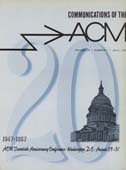July 1967 - Vol. 10 No. 7

Features
The simulation of time sharing systems
The development of new large scale time-sharing systems has raised a number of problems for computation center management. Not only is it necessary to develop an appropriate hardware configuration for these systems, but appropriate software adjustments must be made. Unfortunately, these systems often do not respond to changes in the manner that intuition would suggest, and there are few guides to assist in the analysis of performance characteristics. The development of a comprehensive simulation model to assist in the investigation of these questions is described in this paper. The resulting model has a general purpose design and can be used to study a variety of time-sharing systems. It can also be used to assist in the design and development of new time-sharing algorithms or techniques. For the sake of efficiency and greater applicability, the model was implemented in a limited FORTRAN subset that is compatible with most FORTRAN IV compilers. The use of the simulation is demonstrated by a study of the IBM 360/67 time-sharing system.
A user-oriented time-shared online system
An existing system and planned additions within the Data Processing Laboratory of the Brain Research Institute at UCLA is described. The system represents an attempt to provide research workers of the Institute with the ability to interact directly with a highly sophisticated digital computing complex in the most direct and simple fashion possible. It is anticipated that, with the accumulation of experience using the present system, significant advances will be possible in the system design through determination of interface parameters between the biological scientist and the digital computer.
The internal organization of string processing systems is discussed. Six techniques for data structures are presented and evaluated on the basis of: (1) creation of strings; (2) examination of strings; and (3) alteration of strings. Speed of operation, storage requirements, effect on paging, and programmer convenience are also considered. One of the techniques, single-word linked blocks, is used in an example demonstrating an implementation of a SNOBOL string processing language on an IBM System/360.
Implementing phrase-structure productions in PL/I
A method is described for implementing the productions of a context-free phrase structure grammar in a PL/I procedure whose structure and statements parallel the structure and notation of the grammar.
Plotting a function of three independent variables
A method is developed for constructing an approximate plot of a function of three independent variables. The plot is similar to a conventional contour map except that there are three scales to represent the independent variables. Scale values of the three independent variables are added vectorially, and the value of the function is then read from the values associated with nearby contours.
On the representation of symmetric polynomials
Relations are given between certain symmetric polynomials in the light of the theory of the symmetric group. Such an approach unifies earlier work and lends insight to previously published work by Aaron Booker. A generalization of Graeffe's root-squaring technique for the determination of the roots of a polynomial is suggested.
Optimal starting values for Newton-Raphson calculation of x1 2
The problem of obtaining starting values for the Newton-Raphson calculation of √x on a digital computer is considered. It is shown that the conventionally used best uniform approximations to √x do not provide optimal starting values. The problem of obtaining optimal starting values is stated, and several basic results are proved. A table of optimal polynomial starting values is given.
A language independent macro processor
The problem of obtaining starting values for the Newton-Raphson calculation of √x on a digital computer is considered. It is shown that the conventionally used best uniform approximations to √x do not provide optimal starting values. The problem of obtaining optimal starting values is stated, and several basic results are proved. A table of optimal polynomial starting values is given.
Description of basic algorithm DETAB/65 preprocessor
The basic algorithm for the conversion of decision tables into COBOL code is contained in the generator portion of the DETAB/65 preprocessor. The generator analyzes a decision table and produces simple COBOL conditional statements. Core storage is saved by using queueing techniques and extensive indexing and also by outputting the code as it is generated, a line at a time. The only optimization attempted is the elimination of obviously unnecessary tests on certain conditions in the decision table.
Since the preprocessor and this language associated with it were developed for COBOL users, the preprocessor was written in a modular form in required COBOL-61.
A method for finding Hamilton paths and Knight’s tours
The use of Warnsdorff's rule for finding a knight's tour is generalized and applied to the problem of finding a Hamilton path in a graph. A graph-theoretic justification for the method is given.
Changes in government procurement policies
Several years ago there was an attempt in Washington to place the selection of government computers in a central, highly placed office. Individual government agencies, led by the Department of Defense, successfully beat back this attempt. Today, two years later, it looks as though other forms of centralization are being worked into the government fabric at lower levels, one in the Department of Defense, another in the General Services Administration.



